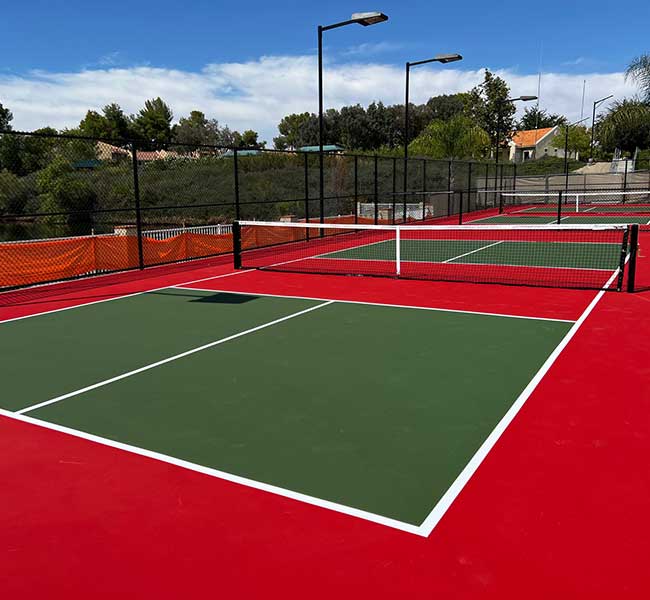Economical Pickleball Court Construction for Homes and Communities
Economical Pickleball Court Construction for Homes and Communities
Blog Article
Sustainable Practices in Pickleball Court Construction You Should Know
As the appeal of pickleball continues to increase, so also does the requirement for lasting practices in court building and construction. This strategy not only addresses ecological concerns but additionally enhances the durability and performance of the courts. From choosing eco-friendly products to applying effective drainage and energy-saving lights solutions, there are countless approaches to take into consideration. The effect of these methods prolongs much beyond the court itself. Recognizing how each component contributes to a much more lasting future welcomes even more exploration right into the complex equilibrium in between recreational development and ecological stewardship.
Choosing Eco-Friendly Products
Choosing environmentally friendly products is a vital action in the building of sustainable pickleball courts. The choice of lasting materials not just minimizes environmental effect yet also improves the longevity and performance of the court. Trick products include reused rubber for the surface, which uses superb resilience and shock absorption while diverting waste from garbage dumps.
Furthermore, utilizing in your area sourced materials lowers transportation exhausts and supports local economies. Pickleball court construction. Making use of indigenous woods for secure fencing and seats can offer a sustainable visual while guaranteeing resilience against the elements.
Including absorptive products for court structures can better contribute to sustainability by enabling all-natural water drain and minimizing overflow. These choices not only shield local environments but also advertise much healthier play settings.
Reliable Drain Solutions
While the choice of environment-friendly products is essential, implementing efficient drainage remedies is just as important for preserving sustainable pickleball courts. Correct drain not only protects the court surface area from water damage yet likewise lessens erosion and overflow, promoting ecological stability.
Effective drain systems can consist of permeable paving, which enables water to penetrate the ground as opposed to pooling on the surface area. This reduces the chance of standing water, which can lead to mold and various other upkeep problems. In addition, integrating strategically put water drainage channels and swales can direct excess water away from the court area, making sure a dry playing surface and preventing dirt erosion.
Utilizing native plant life in the landscape design around the courts can better improve drain by soaking up excess water and decreasing drainage. These plants require less watering and advertise biodiversity, straightening with sustainable methods.
Moreover, it is important to routinely maintain the drainage system to ensure its long-lasting efficiency. This includes cleaning debris and monitoring for obstructions. By prioritizing reliable water drainage remedies, pickleball court fitters can significantly add to the sustainability and longevity of the facility, eventually benefiting both players and the setting.
Energy-Efficient Lights Options
As the need for pickleball continues to expand, integrating energy-efficient illumination choices into court design has ended up being increasingly important for sustainability. Traditional lighting systems commonly visit eat extreme power, contributing to greater operational expenses and ecological effect. Embracing modern, energy-efficient modern technologies is essential for both new constructions and restorations.
LED (Light Emitting Diode) lights attracts attention as a top selection as a result of its durability and energy financial savings (Pickleball court construction). Contrasted to traditional lighting, LEDs make use of roughly 75% much less power and can last as much as 25 times much longer, dramatically decreasing maintenance expenses. Furthermore, the directional nature of LED lighting decreases light contamination, making sure that illumination is concentrated on the court as opposed to surrounding locations.

Lasting Surface Area Alternatives
Exploring lasting surface choices for pickleball courts has obtained traction among gamers and home builders alike. The emphasis on green products not just straightens with the growing environmental understanding but also boosts the efficiency and resilience of the courts.
One prominent alternative is using recycled rubber, which can be sourced from utilized tires. This material offers superb shock absorption, reducing the risk of injuries for players while promoting sustainability. Additionally, modular floor tiles made from recycled plastics use another practical choice. These ceramic tiles are simple to set up and replace, and their convenience permits various court setups.
All-natural turf courts are likewise emerging as a sustainable selection, promoting biodiversity and minimizing the warmth island result. Nonetheless, they need normal upkeep and water, which may not line up with all sustainability objectives.

Water Conservation Techniques

An additional effective strategy involves the installation of rainwater harvesting systems. These systems gather and store rain for use in preserving court surfaces and landscaping. This strategy not only preserves drinkable water but additionally minimizes reliance on municipal resources.
Moreover, employing drought-resistant landscape design around the courts is necessary. Native plants require less water and are much better adjusted to local climate problems, thus reducing general water consumption. Furthermore, using reliable watering systems, such as drip watering, ensures that water is provided directly to plant roots, decreasing dissipation and waste.
Verdict
Integrating sustainable practices in pickleball court building and construction significantly contributes my latest blog post to environmental preservation and source additional hints effectiveness. Using eco-friendly materials, executing efficient drain options, and embracing energy-efficient illumination alternatives can considerably minimize environmental impact. Furthermore, exploring lasting surface area options and employing water preservation methods improve the overall sustainability of these leisure centers - Pickleball court construction. By prioritizing these methods, the building and construction of pickleball courts can straighten with wider ecological goals while advertising longevity and capability within neighborhoods.
As the popularity of pickleball proceeds to rise, so too does the demand for lasting techniques in court construction.Selecting eco-friendly materials is a vital action in the construction of sustainable pickleball courts. By prioritizing energy-efficient lights choices, pickleball court erectors can add to a much more sustainable future while meeting the needs of players and stakeholders alike.Including lasting surface area options not only boosts the efficiency of pickleball courts however also leads the method for carrying out efficient water conservation strategies.Including sustainable techniques in pickleball court building and construction dramatically contributes to environmental conservation and resource performance.
Report this page